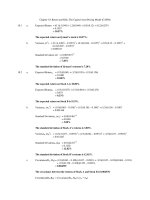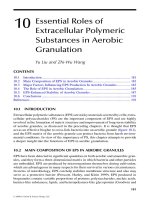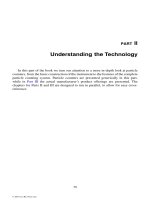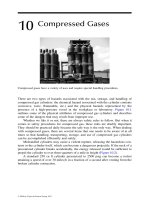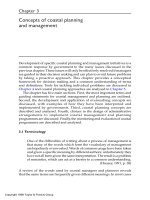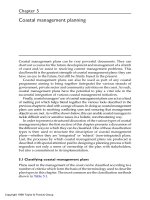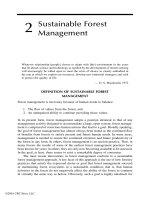GIS for Coastal Zone Management - Chapter 10 doc
Bạn đang xem bản rút gọn của tài liệu. Xem và tải ngay bản đầy đủ của tài liệu tại đây (512.8 KB, 16 trang )
CHAPTER TEN
Decision-Making in the Coastal Zone Using
Hydrodynamic Modelling
with a GIS Interface
Jacques Populus, Lionel Loubersac, Jean-François Le Roux, Frank
Dumas, Valerie Cummins, and Gerry Sutton
10.1 INTRODUCTION AND CONTEXT
There are many kinds of coastal water quality issues. They arise from various
sources of inputs to the coastal zone that are either chronic or accidental. Pollution
of seawater mostly results from a) point source and diffuse pollution originated
from agricultural, industrial and urban activities, or b) pollution from maritime
activities, e.g. waste oil as well as all types of toxic substances being dumped into
the sea, including radioactive ones (Kershaw, 1997).
Toxic phytoplankton blooms are a new plague. Although they are not the
direct result of human behaviour, they are probably linked to human activities, and
particularly contaminated ballast water. These harmful disruptions have severe
effects on shellfish stocks, entailing long production shutdowns. Problems also
currently exist with open sewers discharging into places designated for shellfish
production or into recreational waters (Boelens
et al., 1999).
After flooding, there is run-off pollution from agriculture and urban areas
and nitrate concentrations and bacterial counts increase remarkably. The increase
in nitrate concentrations can lead to dramatic eutrophication, whereas pathogenic
bacteria can make aquaculture products hazardous to human health (Lees, 2000).
Other activities or phenomena such as dredging, deep water sludge disposal or
landfill seepage are concerns for water quality and marine living resources
(Sullivan, 2001).
While hydrodynamic modelling results and the handling of geo-referenced
information are becoming more readily available to coastal management
stakeholders within GIS (Geographic Information Systems), there is still a lack of
direct interfacing of model results with baseline mapping data (BASIC, 2001).
This paper discusses solutions to bridge this gap and illustrates them with two case
© 2005 by CRC Press LLC
studies where effective model outputs are being used for improved environmental
management and decision-making.
10.2 HYDRODYNAMIC MODELLING BASICS
Mathematical models (Garreau, 1997) can solve geophysical fluid mechanics
equations using a number of simplifying assumptions. In essence, knowledge of
the bathymetry, wind tide and currents are used to predict water levels and
concentrations of conservative elements over space and time.
The ability of these models to accurately and reliably reproduce the important
features of complex systems has improved considerably along with rapid growth in
understanding of the underlying physical phenomena, and the ability to quantify
them in terms of valid mathematical formulations. The widespread and affordable
availability of high-powered computing facilities has also contributed to this
development, given the heavy processing loads involved in running all but the
simplest models.
Confidence in the predictive capacity of models is governed by the quality of
fit between modelled output data and real field measurements. Standard practice in
building a typical coastal model entails a number of discrete steps, the first of
which involves reconstructing the morphology of the area of interest in the form
of a digital terrain model. The next step involves adding water to the system, and
then setting it in motion through replication of vertical tidal fluctuations and
horizontal wind friction. Together these forcing factors create gradients, which in
turn drive horizontal current flows. A range of assumptions is usually made in
order to simplify the system, and allow it to run effectively. It is recognised that
models do not strive to exactly reproduce in detail all the features of a natural
system; however the aim is to arrive at a situation where the model is capable of
reliably reproducing the principal features through an iterative process of
validation and calibration.
10.3 GIS FOR COASTAL ZONE MANAGEMENT
A Geographic Information System (GIS) is a computer-based information system
used to digitally represent and analyse geographic features. It is used to input,
store, manipulate, analyse and output spatially referenced data (Burrough and
McDonnell, 1998). A GIS can be distinguished from database management
systems or from visualisation packages through its specialised capability for spatial
analysis. The use of GIS for coastal zone management has expanded rapidly
during the past decade and references are numerous (Durand, 1994; Populus,
2000; Wright and Bartlett, 2000). For optimum efficiency, geo-referenced data
should be properly stored in geo-databases built on spatial data model design
(Prélaz Droux, 1995). Some of the greatest challenges currently faced by those
handling coastal zone data are a) the land-sea interface, with different mapping
references in both horizontal and vertical modes, b) water dynamics and the related
temporal issues, and c) 3D display requirements.
© 2005 by CRC Press LLC
10.4 TOOLS AND DATA
10.4.1 Technical details of regional and local models
MARS-2D is a bi-dimensional model using a finite difference method called ADI
(Salomon, 1995). A broad regional model, extending between 40˚N and 65˚ N and
from 20˚ W to 15˚ E with a 5 km grid, is used as a framework in which to embed
further models of smaller extent for areas of interest along French Atlantic and
English Channel coasts. Commonly, the embedding system has up to 5 levels
allowing phenomena to be examined at resolutions from 1km down to 50m. This
type of model is suitable for applications in areas whose waters are typically well
mixed (e.g., coastal or mega-tidal areas). The model is designed to solve for tidal
and wind driven currents and the transport of dissolved materials.
MARS-3D (Lazure, 1998) is a fully finite difference model, in both vertical
and horizontal orientations, which uses a time splitting method based on MARS-
2D for the barotropic mode. Good coupling between 2D and 3D modes has largely
been achieved through the use of iterative methods. MARS-3D is used at
resolutions ranging from 5 km over regional areas of epicontinental seas, down to
100 metres over detailed areas, narrow bays and estuaries. It is currently run
operationally at the regional scale (with a 5 km mesh) on all French seaboards.
Table 10.1 gives an overview of MARS model features.
Table 10.1 Comparison of MARS-2D and MARS-3D main features
Model MARS-2D MARS-3D
Area
English Channel, Bay of
Biscay
English Channel, Bay of
Biscay
Grid and time step From 50m up to 10km ~ 5km, 5 – 20 minutes
Period of time From days to decade Year to decade
Applications
Tide currents, dissolved matter,
salinity under homogenous
conditions
Tide, currents,
temperature, salinity,
transport of dissolved
matter
Type 2D Finite difference 3D Finite difference
10.4.2 The modelling system
A modelling chain has been developed at Ifremer over a period of many years. The
system has a series of pre-processors and tools for the graphic display of results
produced by the MARS computation kernel.
© 2005 by CRC Press LLC
This mathematical model uses some simplified hypotheses to solve the
equations that govern how marine currents and sea levels evolve. In order to
function, the process requires an input water level along the edge of the area of
interest. These boundaries are usually unknown locally, since they are dependent
on tidal and weather conditions, which are themselves usually derived from
modelling over a much larger area. Thus, the modelling process advances through
the generation of a series of sequentially nested models. An initial general model
covering a large area of the continental shelf and the Channel is followed by a
succession of intermediate models of increasingly smaller scope, but higher
resolution. Boundary conditions for the wide-area model are resolved using world
tide models, into which modelled meteorological forcing factors have been
assimilated. The modelling chain can be summed up as follows:
x A generated link calculates the position, extent and resolution of each sub-
model, from the large-area model to the detailed high resolution model based
on computational and hydrodynamic design criteria. Computational efficiency
is optimised by maintaining a maximum resolution ratio (mesh size ratio) of
between four and five between any two consecutively nested models.
Hydrodynamic criteria are observed as far as possible in the design through
avoidance of islands or zones with violent currents, although at present the
system only works when model boundaries are strictly aligned to parallels and
meridians. This link of the chain has a user-friendly graphic interface and
generates a descriptive file of the entire nesting process.
x The second link in this computation chain is a software program which
calculates an interpolated bathymetry for each nested model. The link also has
a graphic interface developed in UNIRAS, which restores a depth for each
calculation link in a file. The bathymetry used for the large-area model has
been validated, and is essentially taken as fixed. However, it is updated on an
occasional basis, as new information becomes available. The MARS-2D
computation kernel is used in both case studies below, where prevailing tidal
currents have a relatively homogenous vertical structure, providing a good
approximation of the mean current fields pertaining in the study areas.
x Lastly, a range of graphic tools are used to display the resulting modelled
outputs which are written in NETCDF format (Rew and Davis, 1990).
NETCDF is a widely used self-documenting format, which also provided a
suitable platform upon which the ArcView portal was subsequently
developed.
10.4.3 Reference mapping data
Currently, coastal practitioners must refer to common baseline or reference data,
i.e., primary data to which secondary (or more application-related) data will be
subsequently linked (Allain, 2000). The coastline, bathymetric data, and major
administrative boundaries are examples of such baseline data that could be readily
© 2005 by CRC Press LLC
provided to a wider public under optimal conditions of accuracy, updating, and
scalability to suit various needs.
However, it is noted that the bathymetry of inter-tidal areas, and other near-
shore zones, is often less easily available or poorly defined. Such paucity of data is
usually associated with the high cost of acquisition and restricted accessibility.
Bathymetric data for the two study sites under consideration was available from
the French hydrographic service at a scale of 1:50, 000.
ArcView™ was the main GIS platform used for the studies, within which the
Spatial Analyst™ extension facilitated a number of operations on raster images
such as recoding, resampling, changing extent, computing statistics and the use of
algebraic image combination functions. Existing ArcView functionality also
facilitated interactions between raster and vector data layers drawing on the
attributes of file features attaching to vector data sets. However a major hurdle
remains in the efficient handling of large numbers of raster data layers that
typically accrue as the output from multiple model runs.
10.4.4 An Integrated GIS/model interface
The primary rationale behind the creation of a GIS/model interface was to allow a)
consultation and display of results contained in the output files produced by the
MARS hydrodynamic model; and b) extraction of these results to import them to
ArcView. The concept was initially tested through the development of ModelView
(Loubersac
et al., 2000), a prototype interface the functionality of which was
successfully demonstrated in the case of hydrobiological contamination in the Bay
of Marennes-Oléron, France.
As a further development, in order to broaden the scope of application a
platform-independent stand-alone interface, MODELCON, was designed for use in
conjunction with a range of GIS packages. In order to ensure optimum
compatibility with standard software packages and other GIS (e.g. Excel,
MapInfo™ etc.), MODELCONV extracts NETCDF files to a standard ASCII
format. The MODELCONV interface was developed in JAVA, with Microsoft’s
Visual Studio 6 environment and the JAVA library to access NETCDF files
(NETCDF JAVA version 2), ensuring maximum portability in anticipation of
future use on Unix systems or via the Web.
10.4.5 A Geographic conversion module
An additional processing module was developed in order to address specific
geoprocessing requirements beyond those available in the standard version of
ArcView. This module operates as an ArcView extension and was implemented in
Avenue. It enables the user to perform a range of geodesic processing operations
on point, multipoint, polyline and polygon data, as well as 2-D and 3-D related
measurements (pointM, multipointM, polylineM, polygonM, pointZ, MultipointZ,
PolylineZ, PolygonZ).
© 2005 by CRC Press LLC
This module also allows data to be projected or unprojected, i.e. as
geographic co-ordinates (latitude, longitude), or projected Cartesian co-ordinates
including 3-D (X, Y, Z). Other operations that are supported include:
x switching between geodesic systems: WGS 84, NTF and Europe 50;
x switching ellipsoids: Clarke 1880, IAG GRS 80 and Hayford 1909;
x switching projections: Lambert (various), Transverse Mercator (UTM).
10.5 CASE STUDY ONE: SHELLFISH PRODUCTION IN THE GOLFE DU
MORBIHAN, SOUTHERN BRITTANY
10.5.1 Water quality issues in the Golfe du Morbihan
The Golfe du Morbihan is located in southern Brittany, France. Enclosing an area
of 125 km
2
, with many islands and extensive intertidal flats, the basin connects to
the open ocean via a 1km wide channel. Its perimeter is highly indented, and is
traversed by numerous streams and rivers. The main anthropogenic pressures
related to two main cities, Auray (11,000 inhabitants) and Vannes (50,000
inhabitants), are augmented by very significant seasonal tourist populations.
Important natural shellfisheries (
Venus spp.) are commercially exploited, and the
gulf also supports a valuable oyster farming industry. Both rely on suitable water
quality being maintained within narrow sanitary limits. In general, water and
shellfish quality criteria are set by the EU Shellfish Hygiene Directive (Lees,
1995). However, at national level slight differences are found in the interpretation
of shellfish hygiene
E. coli guidelines, specifically in stating what proportion of
samples must fall under the concentration thresholds and in the treatments required
prior to human consumption (BASIC, 2001). In France, these values are defined
by the modified decree n° 94-340 of 28 April 1994, as shown in Table 10.2 below.
Shellfish farmers must take different measures for depuration with respect to these
categories.
Table 10. 2 French shellfish hygiene categories
Level of contamination in faecal coliforms*
Categories
300 1,000 6,000 60,000
A
t 90% d 10%
0%
B
t 90% d 10%
0%
C
t 90% d 10%
D > 10%
* per 100g shellfish
© 2005 by CRC Press LLC
10.5.2 Microbiological modelling
Faecal coliforms (FC), of which
Escherichia coli is a major component, are good
indicators of bacteriological contamination levels in seawater and shellfish. EU
health standards for recreational waters and shellfish harvesting zones are based on
organism counts. These bacteria mainly come from rivers and streams which
receive waste water from various sources including surface runoff and soil
outwash, sewage treatment plant discharges (especially in heavy rainfall situations,
when function is impaired by lower residence time) and unauthorised discharges.
Other direct sources are storm water drain systems discharging directly into the sea
and diffuse contamination in the vicinity of moored boats.
Coliform bacteria do not tolerate exposure to solar UV radiation, and thus
have a limited life span in seawater. Their survival time will vary depending on
their metabolic state and environmental conditions. Bacterial survival times are
positively influenced by the following:
x lower winter temperatures which can slow down bacterial metabolism and
extend survival based on slower rates of consumption of energy reserves;
x increased turbidity values, linked to levels of suspended solids. Turbidity has
a dual effect, as a potential food source and as protection against solar UV
(ultraviolet) radiation. Turbidity is usually higher in winter, due to greater
discharge and sediment resuspension.
In general modelling applications, bacterial survival is represented by the
term T90 (being time at which 90% of the bacteria will have disappeared), which
assumes an exponential rate of decline in numbers. Values for T90 are normally
established on an empirical basis, and those used in the current study were based
on experience at local sites (Guillaud, 1997).
10.5.3 Simulation descriptions
In order to characterise coliform distributions under a range of environmental
conditions, a series of MARS 2-D model simulations were undertaken in which the
following parameters were varied:
x Tidal conditions. Simulations were made over a period of three weeks
under realistic tidal conditions, i.e. of sufficient duration to capture both
spring and neap cycles.
x Seasonal influence. This was investigated by varying discharge volumes,
i.e. coliform flux.
x Weather conditions. Three sets of commonly prevailing conditions were
selected, in accordance with wind statistics derived from data supplied by
the French meteorological office. These were 1) zero wind (baseline
condition), 2) westerly 8m.s
-1
and 3) north easterly 8ms
-1
.
© 2005 by CRC Press LLC
x T90s. A summer value of 10h, with 24h for winter was chosen in
accordance with local measurements.
x The impact of major malfunctioning of water treatment plants in heavy
rainfall periods. This was modelled by doubling the amounts of bacteria
discharged over a 24-hour period, which is typical of what can occur
during a summer storm. The objective was to investigate the impact of
episodic events on coliform distribution, particularly with respect to
existing zonation patterns.
The above scenarios were investigated through a combined series of seven
simulations (two seasons under three different conditions, plus one exceptional
situation type). In order to assess the validity of the simulations, the resulting
coliform concentration distributions were then categorised according to EU
shellfish farming criteria (Table 10.2). Model-derived zonation patterns were
found to be in broad agreement with existing zonation plans based on both tissue
sampling and water quality monitoring network samples.
10.5.4 Simulation results
Having established the overall validity of modelled results, priority was given to
locating the zones likely to be subject to the highest contamination. These were
found to be in upper reaches of the main rivers and in the bay of Vannes (Figure
10.1). Observations performed during model runs indicated that once steady state
conditions are attained, the spring/neap tidal coefficient has little influence on
subsequent coliform concentrations. The impact of a constant, moderate wind (8
m/s) on contamination plumes was imperceptible, both in summer and winter. In
the summary of results, only the baseline “no wind” situation is referred to.
T90 was found to exert the greatest influence on coliform concentration, and
when set to 24hours gave rise to the highest levels of contamination. This is
reflected in the final model run for which a 24h T90 linked to winter discharge
rates was chosen.
10.5.5 Comparison between the actual classification and a simulation
Figure 10.2 shows the results of zonation categories based on samples collected by
the water quality monitoring network (Ifremer, 2003). Zonations are based around
30 such samples per site that are routinely collected over the course of each year at
low water during each spring tidal cycle (theoretically least favourable situation).
Dots indicate the locations of effluent discharge sources. Figure 10.2 clearly shows
the main water body of the gulf officially ranked as category A, whilst the
estuaries and their outlets (north and northeast) are in the B or D categories. It is
notable that no estuarine areas have been zoned in the C category and have instead
been allocated to category D as a precautionary measure in respect of the EU
Shellfish Directive. This precautionary designation takes into account the obvious
© 2005 by CRC Press LLC
risk of contamination near urban and port areas, as well as the impact of reduced
salinity on mariculture products in upper estuarine reaches.
Figure 10.1 Screen capture from GIS showing the Golf du Morbihan. Coloured areas denote EU
shellfish classifications based on simulated coliform concentration distributions
Comparing the results highlights the good consistency between simulation
results and those obtained from monitoring network observations. Whilst the
general configuration of zonation categories (Figure 10.1) based on simulations is
broadly consistent with the official classification scheme (Figure 10.2), the former
logically appears to give rise to a less conservative regime under which the
estuarine areas in the north and northeastern gulf are designated as category C,
rather than the precautionary official D designation.
This may be explained by the relative shortness of the period simulated (3
weeks), whereas the official designations are based on an annual monitoring cycle.
Other reasons may be that the coliform flows used for the simulation did not
include the annual maxima (in the case of water collection and treatment plant
malfunctions). Furthermore the actual T90 may exceed the 24h value used in
simulations, especially in naturally turbid upper estuarine areas, or as a
consequence of winter storm induced sediment resuspension.
By comparing the Figures where the discharge points are identified by a dot
symbol, we also note that the model, which minimised coliform concentration
levels as seen above, reveals two B category zones in the outer Bay area. These
can be seen in Figure 10.1, located to the north and to the west of the Ile au
Moines (the island is indicated by an M on the map). Their coincidence with
© 2005 by CRC Press LLC
effluent discharge points (dots) suggests the logical cause of reduced water quality
in these areas. This result highlights the valuable insights that can be obtained
through the use of realistic simulations based on numerical models in identification
of localised water quality issues, which may then be addressed through the
allocation of additional monitoring resources. In this case, priority was given to the
northern most area (associated with effluent discharge Arradon) owing to its
proximity to significant shellfish farming areas, resulting in the establishment of an
additional hygiene monitoring station.
Figure 10.2 Screen capture from GIS showing the Golf du Morbihan. Coloured areas denote EU
shellfish classifications based on measured coliform counts.
10.6 CASE STUDY TWO: THE WRECK OF THE IEVOLI SUN
10.6.1 Context of the case study
The Italian chemical tanker,
Ievoli Sun, sailing from Rotterdam to Genoa sank
around 9 am local time on 31
th
October 2000 in the central English Channel,
approximately 9 nautical miles north of Les Casquets (Channel Islands) and 20
nautical miles west-north-west of the French Cap de la Hague off the north coast
of Normandy (Figures 10.3 and 10.4).
© 2005 by CRC Press LLC
Figures 10. 3 and 10.4 Ievoli Sun being towed a few hours before she sank (French Navy sources).
The vessel was carrying three chemical products: 3998 tonnes of styrene
(Vinylbenzene), 1027 tonnes of Methyl ethyl ketone (MEK or 2-Butanone) and
996 tonnes of Isopropyl alcohol (Propanol-2). Although the latter two products are
considered to be practically non-toxic for aquatic life, styrene is known to be
hazardous for the marine environment and for humans. According to the Group of
Experts on the Scientific Aspects of Marine Pollution of the International Maritime
Organisation (GESAMP, 1989) styrene is bioaccumulable with a propensity to
affect edible marine resources. Moreover, it is dangerous for human health when in
contact with skin or when inhaled. It can cause major environmental problems due
to its persistent irritant toxic odour, which can force the closure of beaches.
French Naval investigations in the aftermath of the sinking showed that the
wreck was lying on her port side, and subsequent remotely operated vehicle
(ROV) surveys confirmed that the hold was ruptured with a consequent release of
styrene into the marine environment.
The wreck was located close to the Channel Islands, in an area of high
biodiversity, and in close proximity to shipping lanes, cross-channel traffic,
fisheries, aquaculture, and beaches. Neighbouring coastlines are rugged and highly
indented, with many sensitive and vulnerable sites, and are under the jurisdiction
of several different regional authorities, including those of the Channel Islands.
A rapid response team including experts in pollutant chemistry,
ecotoxicology, modelling, fishery science, aquaculture and digital mapping was
assembled within two hours of the sinking. The prime objectives of this group
were to establish a baseline for environmental contamination, and devise a plan for
coastal environmental monitoring in the subsequent hours. This meant being able
to characterise the fate of pollutants in the water mass and identify sensitive areas
and fish species likely to be affected. Thus the main requirements were (Loubersac
et al., 2002):
x to rapidly compile various forms of multi-thematic information from
multiple sources;
x to provide simulations of pollutant dispersion at sea for several scenarios
in the shortest possible time;
© 2005 by CRC Press LLC
x to standardise these compilations and simulations and make them easy to
display, communicate and update for simultaneous use across several
decision centres.
10.6.2 Simulation of pollutant behaviour using MARS-2D
The MARS modelling suite (Salomon
et al. 1995; Garreau 1997) was used to
rapidly derive a 500m horizontal mesh hydrodynamic model centred on the wreck
position. A 2-D horizontal model was adopted to simulate the local hydrographic
regime, where dissolved substances were likely to become well mixed owing to the
strength of prevailing tidal currents which are relatively consistent throughout the
vertical extent of the water column. Actual wind fields supplied by the French
meteorological office were also assimilated into the model.
Simulations were run to reproduce the evolution of instantaneous and
residual tidal current fields, tidal trajectories and concentrations of the dissolved
fraction of the spilled products. The following three scenarios were considered
assuming maximal dissolution of the styrene in seawater: a) a single total discharge
of 4,000 tonnes, b) simulation of 4,000 tonnes of the product leaking from the
wreck over a period of 3.5 days, and c) simulation of continuous discharge of 20
l.min
-1
over 25 days (closely matching observed leakage rates).
10.6.3 Setting up a customised GIS
A GIS was established for the wreck site and surrounding maritime region, in
which functionality was tailored towards handling and visually representing
marine and coastal data. The main steps in this process were:
x Building a reference geographic data set (Allain et al., 2000) in order to
ensure stakeholder interoperability;
x Conversion of all data into decimal degree geographic coordinates, and
establishing a common vertical reference frame for marine and land-based
topographies;
x Adoption of a uniform map template for all data layers optimised for a
standard working scale of 1:50,000.
10.6.4 Results
The
Ievoli Sun sank in an area in which strong tidal currents and an irregular
seabed give rise to intense vertical mixing. Under these conditions it is reasonable
to assume that styrene escaping from the wreck became rapidly dispersed
throughout the water column. A 3-D perspective view showing the spatial extent
of dispersed styrene as it appeared after 10 days of simulated advection is
illustrated in Figure 10.5. This simulation was based on scenario c) with the
following assumptions:
i) the matter coming from the wreck dissolved completely,
ii) there was no chemical modification over time, and iii) an average current was
responsible for the transport of these dissolved substances.
© 2005 by CRC Press LLC
The image presented in Figure 10.5 was produced by merging modelled data
with those from the GIS mentioned above, using ArcView 3D Analyst. This image
corresponds to the situation on the 9
th
November at 2 am (10 days after the spill),
taking into account the atmospheric forcing data provided by the French
meteorological service. The concentration limits indicated on this Figure are 0.30
ppm (parts per million or mg/l) (darkest), 0.15 ppm (lightest), and 0.05 ppm
(medium-grey) in the raised area.
Figure 10.5 3D perspective representation of the plume of dissolved pollutant dispersion after 10 days.
Dispersion of a continuous discharge of 20 l.min
-1
was also simulated for the
period between 30
th
October and 24
th
November, incorporating actual wind
measurements up to the 19
th
November and forecasts for the remainder of the
simulation period. Plate 10.1 shows the situation at the end of the simulation
(24/11/00 at 0600) with contaminant concentration expressed in parts per million
(ppm). While the bulk of the dilution patch is located along an axis running East
North East – West South West across the wreck site, a distinct branch can be seen
extending southward towards the island of Alderney. However, seeing the very
low flow simulated, the concentrations of dissolved product in the water column
remain extremely low, since the highest concentrations reached in the simulation
did not exceed 0.056ppm. However it should be noted that the overall
concentrations remained below 0.056ppm throughout the water column; such low
values are however consistent with expectations given the low rate of discharge.
© 2005 by CRC Press LLC
10.7 CONCLUSION AND PERSPECTIVES
An operational model of the Golfe du Morbihan was constructed, which
successfully reproduced the hydrodynamic regime of the study area to within
acceptable tolerances. The model has also been used to effectively simulate
patterns of bacterial dispersion, the results of which were generally in accordance
with officially established shellfish zonation patterns, based on the sampling
regimes of local water quality monitoring networks. Time-series of computed
concentrations for specific locations can be extracted from existing model runs,
and can be selected to correspond with monitoring sites. The approach thus
provides a means of optimising sampling programmes to make best use of
available resources, and to improve responsiveness to episodic events with
potential consequences for health.
The present arrangement and state of development of these modules allow a
user to work effectively with a given number of grids generated as output from a
limited number of modelled scenarios. Future developments aimed at automation
would reduce the time needed to process and import results, while maintaining the
traceability of actions run and all the metadata required to understand and analyse
the simulation results. To this end, future efforts will be concerned with
improvements in the following areas:
x Ensuring that model-run relevant metadata which is integral in NETCDF files
is fully maintained throughout the processing chain;
x Transforming the tables that MODELCONV generates into Arcview grids;
x Implementing batch processing tools, both on the MODELCONV level and to
select user-defined time steps, and on operations between variables to generate
more synthetic results than in ArcView, and to import a series of files and
automatic captioning for them.
The effectiveness of the
Ievoli Sun pollution response can be attributed to the
favourable platform upon which it was based. Pre-existing tools could be activated
within 48 hours, facilitating rapid delivery of environmental maps incorporating
hourly forecasts of styrene slick position and concentration. Prudent diagnoses of
the potential effects on marine life could then be made in the light of various
leakage scenarios. Integration was made possible by providing consistent geo-
coded information on the land-sea interface, through a GIS interface closely
connecting these data and simulations issued from digital models. Integration of
consistent geo-coded information on the land sea interface with model simulated
outputs within a GIS environment has resulted in the creation of an active interface
for pollution response decision makers that incorporates up-to-the-hour scientific
assessments.
A further logical extension of this work would be to jointly use
hydrodynamic, sedimentological and biological modelling combined with GIS.
Links with catchment models to allow regional-scale assessments of human
activities (e.g. agriculture) and natural events (e.g. flooding) should also be
considered. Planned future work will incorporate sedimentological and biological
© 2005 by CRC Press LLC
process modules into the existing hydrodynamic modelling/GIS schema, thereby
increasing the diversity of assessments that can be made. Critical coastal
management issues including bacterial and viral contamination of bathing waters,
occurrence and impact of harmful algal blooms, eutrophication, and definition of
coastal water masses (e.g. in relation to the EU Water Framework Directive) could
then be addressed.
It is anticipated that schema will ultimately be extended in order to
incorporate links with catchment models, thereby allowing regional scale
assessments of human impacts (e.g. agriculture) and natural events (e.g. flooding).
10.8 REFERENCES
Allain S.,
et al., 2000, Données géographiques de référence en domaine littoral. In
"Geomatics and Coastal Environment", edited by Populus, J. and Loubersac, L.
(Editions Ifremer/Shom), pp. 67-79.
Boelens R.G.V., Walsh A.R., Parsons A.P., and Maloney D.M., 1999, Ireland’s
Marine and Coastal Areas and Adjacent Seas: An Environmental Assessment.
Quality status report. Prepared by the Marine Institute on behalf of the
Departments of Environment and Local Government and Marine and Natural
Resources, Dublin.
BASIC, 2001, A Scoping Study to Establish a Common Approach to Examining
the Impact of Atlantic Arc Water Quality and Dynamics on Coastal Activity and
Sensitive Marine Environments, Atlantic area INTERREG-IIC programme. Final
report, (Cork, Ireland: CRC).
Durand H.,
et al., 1994, An example of GIS potentiality for coastal zone
management: Pre-selection of submerged oyster culture areas near Marennes
Oléron (France).
EARSEL Workshop on Remote Sensing and GIS for Coastal
Zone Management
. Delft, The Netherlands, 24 - 26 Oct.
Garreau P., 1997, Caractéristiques hydrodynamiques de la Manche.
Oceanis, 23(1)
pp. 65-97.
GESAMP [Joint Group of Experts on the Scientific Aspects of Marine
Environmental Protection], 1989, The evaluation of the hazards of harmful
substances carried by ships: (revision of GESAMP Reports and Studies n° 17).
GESAMP Reports and Studies, 35: 44p., [11] annexes.
Guillaud J.F., Derrien A., Gourmelon M., and Pommepuy M., 1997, T90 As a tool
for engineers: Interest and limits.
Wat. Sci. Tech., 35(11-12), pp. 277-281.
Ifremer, 2003, (on-line.
Accessed October 2003).
Kershaw, P.J., 1997, Radioactive contamination of the Solway and Cumbria
coastal zone: The Solway Firth,
ECSA/JNCC, pp 43-50.
Lazure P. and Jegou A.M., 1998, 3D modelling of seasonal evolution of Loire and
Gironde plumes on Biscay Bay continental shelf. In 5ème Colloque International
d'Océanographie du Golfe de Gascogne.
Oceanologica Acta, 21(2).
Lees, D.N., Nicholson, M., and Tree, J.A., 1995, The relationship between levels
of
E. coli in shellfish and in seawater with reference to legislative standards.
Lees, D.N., 2000, Viruses and bivalve shellfish
. Int. J. Food Microbiol. 59, pp. 81-
116.
© 2005 by CRC Press LLC
Loubersac L., Salomon J.C., Breton M., Durand C., and Gaudineau G., 2000,
Perspectives offertes par la communication entre un modèle hydrodynamique et
un SIG pour l'aide au diagnostic environnemental; caractérisation de la
dynamique et la qualité des masses d'eaux . In
"Geomatics and Coastal
Environment"
, edited by Populus, J. and Loubersac, L. (Éditions Ifremer/Shom),
pp 173-185.
Loubersac
et al., 2002, Communication de l’information géographique maritime et
côtière pour la gestion d’une crise environnementale.
Revue internationale de
Géomatique
. 12(3), pp. 355-371.
Populus J. and Loubersac L., 2000, (eds), CoastGIS’99: Geomatics and coastal
environment. (Brest: Éditions de l’Ifremer).
Prélaz Droux R., 1995,
Système d’Information et Gestion du Territoire. (Lausanne:
Presses Polytechniques et Universitaires Romandes. Coll. META)
Garreau P., 1997, Caractéristiques hydrodynamiques de la Manche.
Oceanis, 23(1)
pp. 65-97.
Rew, R. K. and G. P. Davis, 1990, NetCDF: An interface for scientific data access.
Computer Graphics and Applications, IEEE, pp. 76-82, July 1990.
Salomon J.C., Breton M., and Guegueniat P., 1995, A 2D long term advection-
dispersion model for the Channel and Southern North Sea. Special Issue MAST
52, part B and C.
Journal of Marine Systems, 6(5-6), pp. 495-528.
Sullivan, N., 2001, The relationship between the disposal site and the SAC in
Falmouth bay, south-west England.
Unpublished Dissertation, Msc in Estuarine
and Coastal Zone Management
.
Valuing our environment, 1999,
National Trust (UK).
Wright D. and Bartlett D., 2000,
Marine and Coastal Geographical Information
Systems
. (London: Taylor and Francis).
© 2005 by CRC Press LLC
